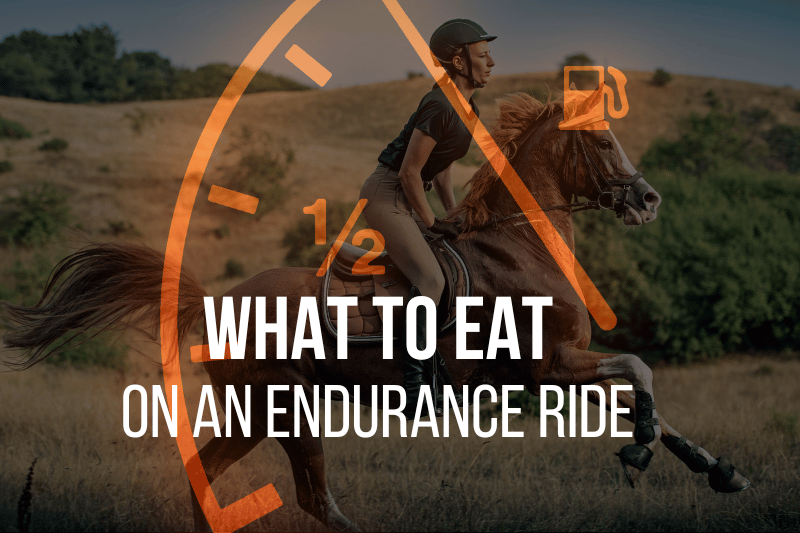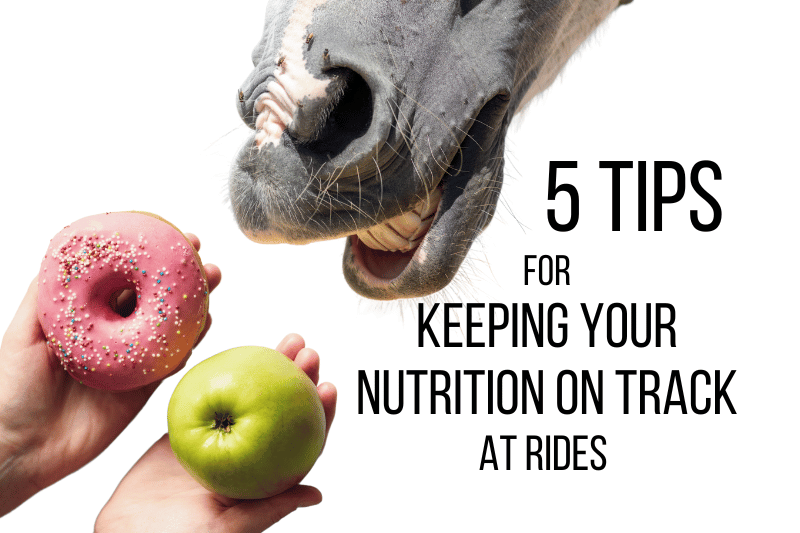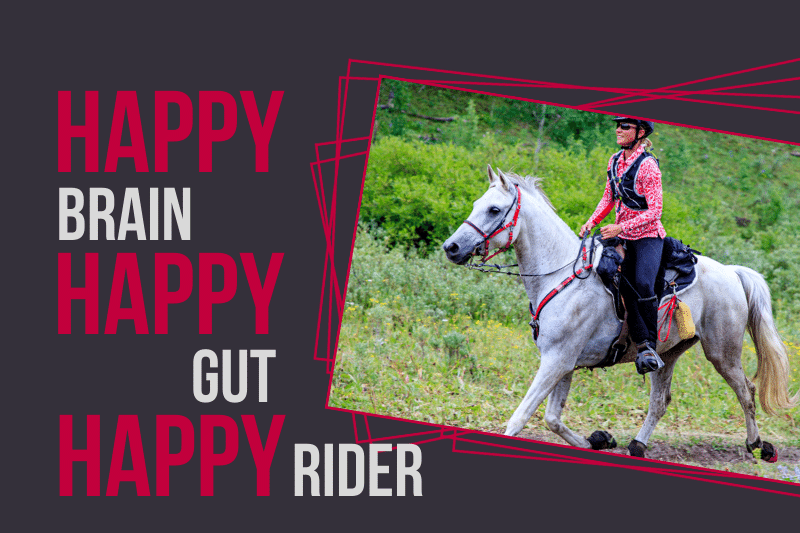What you eat during an endurance ride can dramatically affect how you feel, and even the decisions you make, throughout the event. It’s easy to get distracted by your horses’ needs, but fueling yourself properly is critical. This post explores how to eat for a stronger, smarter ride.
General Principles for Eating During an Endurance Ride
The more experience I gain as both an endurance rider and a trail runner, the more I see the value of applying sports nutrition strategies to long days in the saddle. Although everyone is different, and each rider needs to experiment with what works for him or her, there are some general principles that serve as a starting point for most athletes.
Take Fueling Seriously
Despite all the effort and expense we pour into fueling our horses, many of us neglect the brains of the outfit: ourselves. This is unfortunate, as our horses rely on us to make good decisions for the welfare of both partners.
A smart fueling strategy is surprisingly helpful for staving off physical fatigue. Obviously, this helps us maintain a strong, balanced seat to avoid unfairly burdening our horses. We’ve all also observed that riders who remember to eat properly tend to be nicer to vets and fellow competitors.
Perhaps less acknowledged is the value of maintaining steady levels of blood glucose to support us mentally. Both hypoglycemia (low blood sugar) and hyperglycemia (high blood sugar) negatively affect judgement. In many sports, more injuries occur as the event progresses not due to physical fatigue, but to mental fatigue.
Fueling your body and brain isn’t a distraction from your horse ~ it’s a gift to him.
Eat Calorie-Dense Foods
Endurance riding involves hours of jostling, core stabilization, anxiety, excitement, and exposure to the elements. Few people perform well with a full stomach under those circumstances…but they don’t perform well without fuel, either. Part of the solution is to choose foods that are calorically dense, so you can eat small quantities but still get the energy you need.
Balance Macronutrients
Fats, proteins, and carbohydrates all have their purpose in a ride-day fueling plan. Fats are tasty and calorie-dense. Protein, though more commonly associated with physiological repair between bouts of exercise, is also calorie-dense and satisfying during a ride.
Carbohydrates (supplemented with stored bodyfat) represent a primary source of fuel during endurance efforts. You can choose simple carbs (like processed grains, sugars, and most energy gels and drinks) for a quick hit or complex carbs (like whole grains, beans, and veggies) for a more sustained burn.
Simple carbs have their place, such as when you’ve neglected fueling too long and need to boost your blood sugar quickly. They also tend to be tasty, easy to eat, cheap, and readily available in portable packaging. However, it’s easy to overdo simple carbs, especially when you’re working at low-to-moderate intensity, as with most riding. Too many simple carbs set you off on the blood sugar roller coaster ~ spiking and crashing, then eating more, then spiking and crashing again. Too much sugary stuff also upsets many riders’ stomachs.
Complex carbs reduce the rollercoaster effect, especially if eaten with a little fat and/or protein. However, they are often bulkier, harder to consume, less available in convenient packaging, and less appealing to hot, hard-working athletes.
UCAN makes sports nutrition products with a unique “super starch” that provides steady energy without spiking blood sugar. This has become my fuel of choice for running and endurance riding. Happily, my readers can get a discount on anything in the UCAN store.)
Many riders find that the best choices for breakfast and lunch combine all three macronutrients. This helps moderate blood sugar levels because fat and protein have a slower, steadier burn than carbohydrate. You’ll see this reflected in the meal suggestions below.
Pro tip: Add a bit of fresh produce to as many meals and snacks as possible. The water and fiber will help keep your nervous guts processing normally.
Fuel Preemptively
If there’s one thing endurance riders can take away from athletes in other sports, it’s the importance of fueling before you think you need to. Waiting until you feel hungry, hangry, woozy, or weak puts you in a hole that’s hard to escape. Better not to fall in there in the first place.
Taking in a small, steady amount of fuel frequently (at least hourly) is ideal. However, it can also be challenging when you’re trying to manage a 900-pound prey animal moving at high speed through wilderness terrain. I like to have UCAN‘s energy powder in my water, and/or their energy gels in a saddle bag. This makes it easier to stay topped up without upsetting my stomach.
Eat Familiar Foods
An endurance ride is no place to unleash your culinary curiosity. Even riders who normally have iron stomachs frequently recommend caution when eating on ride day.
Choose foods that you know from experience will sit well on your stomach. You don’t want anything that causes nausea, gas, acidity, heartburn, or unscheduled porta-potty visits. Ideally, test different foods on long conditioning rides so you know they work for you in conditions that mimic the race day experience.
Pack Appealing Foods
Many people tend to lose their appetite during the excitement, stress, dehydration, weariness, and heat of an endurance event. You can counteract this tendency by planning meals that are very appealing.
Many riders, including myself, pack food that they wouldn’t normally eat at home. Sometimes, what’s appealing and sits well isn’t the best long-term nutritional choice, but it may be just the thing to keep you going during the event. If all you’re going to eat at mile 80 is fried chicken and Triscuits, then you might as well have some on hand.
Ideally, you’ll come up with some tried-and-true choices that your brain interprets as a “treat,” but that is also reasonably healthful.
Ideas for Breakfast Before an Endurance Ride
Breakfast before a ride can be tough. Some of us don’t normally eat that early, plus we’re nervous and busy preparing our horses. Still, most people really need to eat something if they’re going to be at their best for the challenge ahead.
Here are some calorie-dense, macronutrient-balanced breakfast ideas for ride day:
- Eggs and corned beef hash
- Peanut butter toast with jelly or honey
- Greek yogurt with granola and fruit
- Oatmeal and pre-cooked sausage patties (This is what my stomach wants at rides lately. I mix a scoop of UCAN protein + energy powder into the oatmeal to help moderate blood sugar.)
- Coconut pumpkin chia pudding
- Protein powder shake and energy bar
Caffeine presents an interesting challenge. Those of us accustomed to starting our day with coffee generally don’t want to drink much of it on ride day, lest we have go pee during the first loop. Here are some alternatives to your usual vat-o-joe:
- Drink one, very strongly brewed cup. (This is my method of choice.)
- Drink one, normal cup and supplement later with coconut water infused with espresso.
- Eat a few chocolate-covered espresso beans.
- Take electrolyte capsules with caffeine (Definitely try this at home first.)
Pro tip: On a hot day, send a small thermos of iced coffee with heavy cream out to the vet check. Trust me, it tastes amazing at 10:00 a.m. on a 100-miler.
Ideas for Lunch During an Endurance Ride
Lunch can be tricky, especially if you don’t have crew. You’ll be busy, so consider what can be prepared ahead of time and eaten quickly. You may also be feeling a little green around the gills, so have a few appealing options.
Lunch at the trailer is easiest because you have ready access to your fridge or cooler, utensils, and a place to tie your horse. Here are some ideas:
- Tuna salad or chicken salad with whole-grain crackers
- Hardboiled eggs or egg salad
- Peanut butter and jelly sandwiches
- Cold cuts, cream cheese, and avocado wrapped in a tortilla
- Cold pizza
- Potato salad and rotisserie chicken
- Hearty canned soups or stews
- Meal replacement shakes, like Ensure, work great for some. Try it at home, though, because it makes others sick as it’s mostly maltodextrin with some protein added. A quality protein-plus-energy powder like the ones from UCAN is another alternative.
- Veggies and hummus
- Cottage cheese with berries and almonds
Remember to include a bit of produce: Coleslaw, pre-sliced veggies, watermelon, and bites of your horse’s carrots or apples work well.
Lunch at an away hold presents some extra challenges. It often needs to survive many hours in a crew bag without refrigeration. You’ll probably be holding your horse with one hand, so you don’t want anything that involves a lot of prep, utensils, or mess. I like to pack everything in a zip-top bag that will also contain trash when I’m finished.
- Tuna or chicken salad in single-serve packets (remember a plastic fork)
- Crackers
- Beef sticks or jerky (Epic Provisions makes high-quality meat-based bars in several, tasty flavors.)
- Uncrustables PBJ, packed frozen and allowed to thaw while you ride
- Individual packets of pickles are surprisingly refreshing on a hot day, and many distance runners swear by pickle juice to prevent muscle cramps
- Oatmeal cookies with raisins and walnuts
- For some produce, try applesauce packets or single-serve containers of canned fruit.
Remember, you have to get back on that trotting horse, so be very careful not to overeat! It’s better to consume a smaller lunch and continue fueling on the trail than to ride with a full stomach.
Ideas for Snacks on the Endurance Trail
Some riders always get hungry on the trail. Others never eat between holds. My natural tendency is to fall in the latter category, but I’m finally learning that I feel much better if I make a point of fueling hourly.
The best options for snacking in the saddle are calorie-dense, easy to eat one-handed, uncrushable, and don’t melt. Here are some ideas:
- Larabars
- UCAN energy bars (Get the kind without chocolate coating for mess-free snacking in hot weather.)
- Beef sticks or EPIC bars
- Energy gels (I use UCAN‘s instead of the common sugar-based variety.)
- Single-serving nut butter packets
- Trail mix
- Mamma Chia squeeze packs
Electrolytes
Most riders perform best when they consume electrolytes ~ but they have to be the right electrolytes. Different products work for different people, and the ones that don’t work have a nasty tendency to cause stomach upset. Definitely experiment ahead of time to see what works for you.
As with calories, the key to electrolyting is to take it before you feel like you need it, and to consume enough but not too much. Most people find that small, frequent doses (like sipping from a bottle) works better than chugging a bunch at once. I like to keep plain water in my running vest and electrolyte-spiked water in my saddle bag. I also use a certain color bottle for electrolyted water so the flavor doesn’t “contaminate” plain water in the future.
I’m a huge fan of LMNT (pronounced “Element”) electrolytes. The flavors are tasty and not too sweet (they’re lightly sweetened with stevia leaf extract) and it’s the only electrolyte drink that my tastebuds and stomach will tolerate.
What you eat during an endurance ride matters! Test different fuels during long conditioning rides, bring easy options, and remember to keep the calories trickling in from dawn ’til done.
You might also like
This post includes affiliate links, and I may earn a small commission (at no extra cost to you) when you purchase through these links. I only recommend products and services I think are helpful and useful. Thanks for helping me offset the cost of maintaining this blog as a free resource!






This is a great article . You should try to get it posted in Endurance News . They need to publish more informative articles like this.